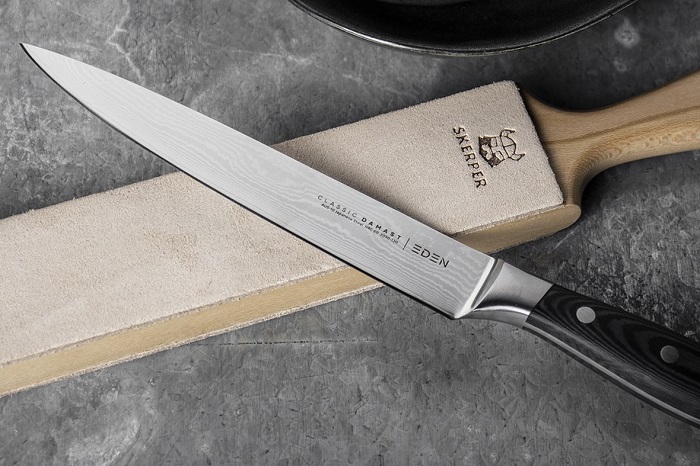
Source: knivesandtools.com
Whether you’re a cook, outdoor enthusiast or construction worker, using a knife is probably something you do on a daily basis. Contrary to what many people think, dull knives are actually far more dangerous than sharp knives. A sharp knife can make cuts without as much effort, whereas a dull knife may require you to use extensive force to cut through food, wood or any other material.
That being said, knife sharpeners are a must-have accessory for people using knives on the regular. There are many different tools and techniques used to sharpen knives. Using honing steels is one of the most popular techniques that doesn’t require too much explaining. One of the most underrated techniques used for finishing and ensuring your knife is razor-sharp is stropping. To do so you need to get a leather sharpening strop.
Stropping is a sharpening technique commonly used by barbers, where they use a leather sharpening strop to maintain, polish and sharpen the edge of the razor. It smoothens the blade, realigns the cutting edge by removing the excess metal shavings left out from the honing stone. While some strops are made of materials like linen, leather is the most common material. Both suede and smooth leather can be used. You can find leather sharpening strop products made using cow leather, which isn’t a popular option among animal loves, who prefer strops made from linen or other textiles.
The term strop refers to anything that’s used in the last sharpening stages and isn’t a steel or stone. Besides leather, it encompasses a few other materials like balsa wood, newspapers, denim, linen, cotton, nano cloth and microfibers. The combination of materials used in the stropping tool will have a distinct effect on the knife’s edge. Besides the materials used in the stropping tool, strops come in a few different types based on how they’re intended to be used.
Types of Strops

Source: bestdamascusknife.com
Strops come in two basic types – hanging and bench strops. Hanging strops are tools that the barbers and shavers use. These strops are usually affixed to a knob, hook or towel, and you can pull it tight and conform it to the knife’s edge. Bench strops, on the other hand, are typically used for sharpening knives, razors and other tools. Bench strops are generally mounted on a hard and flat surface that can be either metal, wood or acrylic. There are also handheld and mounted strops. Mounted strops have the leather affixed to a solid wood like maple. So depending on your work style and the type of knife or tool you’re working with, you should find a strop that’s suitable for your specific needs.
Steps to Stropping a Knife

Source: pinterest.com.au
First and foremost, you need to make sure that your knife can be stropped. If you have a knife with a serrated blade, stropping is impossible. It will just damage your knife. If your knife has a curved blade, make sure you get a razor strop. Then, you have to make sure your knife is sharpened well, otherwise, you’ll end up stropping it for hours with little to no results.
Next, prepare for the process by getting all the required tools. This is the part where you need to buy a leather sharpening strop and rinse your knife. If you already have a strop, clean it thoroughly before using it. This is because metal shavings from previous strops can still be found on the tool. Rubbing alcohol is a great solution. Then, you need to get the stropping angle right. As a general rule of thumb, don’t use the same angle for sharpening and stropping a knife.
For instance, if the sharpening angle is 20°, the stropping angle should be narrower. Keep in mind that the stropping motion should be the exact opposite of the sharpening motion. This is because you want to avoid cutting into the strop. Pull your knife slowly in backward motion from the heel to the tip, and try using the same angle throughout the entire process. Once you feel like you’ve stropped one side, flick the blade and do the same thing on the other side of the knife. Ideally, you want to do this interchangeably, going up to seven swapping passes.
Final Thoughts

Source: kayakfisherly.com
Making sure your knives are sharp is essential to avoiding accidents when working with them. A dull knife is a dangerous knife, which is why people who use knives on a regular basis invest in quality sharpening, honing and stropping tools. Stropping is one of the lesser-known methods to finish the sharpening of a knife, yet it’s very important to the quality of the cuts your knife will make. You’ll find a range of stropping tools, all of which serve a different purpose and are meant for different types of stropping. Find one that suits your specific needs, and follow the aforementioned steps to properly strop your knives.












